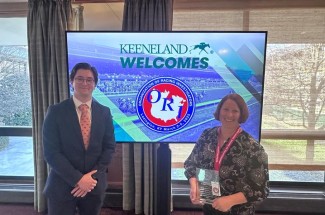UK SMRI Equestrian Athlete Initiative presents jockey safety findings at ORI conference

Leaders in the horse racing industry are focusing on ways to improve safety within the sport. The University of Kentucky Sports Medicine Research Institute (SMRI) is specifically aiming to find what, where and who needs their targeted interventions that can be designed to help improve safety.
The SMRI Equestrian Athlete Initiative recently attended the Organization of Racing Investigators (ORI) conference at Keeneland Racetrack.
Kimberly Tumlin, Ph.D., UK College of Health Sciences assistant professor and research director of the Equestrian Athlete Initiative, and Landon Cord, undergraduate research intern, were invited to the conference to present an overview of the research that the Equestrian Athlete Initiative has been conducting over the last five years.
This initiative specifically focuses on the human side of the racing industry. Their mission is to optimize health, wellness and performance of equestrians across their lifespans through research and community engagement.
Tumlin and Cord’s research findings focused on different members of the equine community including those with direct horse contact daily, like jockeys, exercise riders and horse grooms, compared to those who don’t have direct horse contact daily, like racetrack investigators or bloodstock agents, on being able to correctly identify concussion symptoms.
“A survey was sent out by the Equestrian Athlete Initiative, and I had the chance to evaluate everything that was collected,” Cord said. “We evaluated people’s prior concussion education and current concussion knowledge. It points us in the direction of what should be looked at further in terms of providing a higher level of care within the racing industry.”
Equestrians have the highest rate of adult concussions for any sport in the U.S., and from SMRI’s research, they found that two-thirds of jockeys report having at least one concussion in their career.
“We know the jockeys, exercise riders and others who are handling the horses in the gates or on the grounds are also at high risk of injury,” said Michaela Keener, Ph.D., UK College of Health Sciences assistant professor and Equestrian Athlete Initiative faculty. “Finding out how much of the industry knows how to identify concussion, especially since it’s not a physical injury that you can see, is really important to try to help this community.”
Through their survey, the Equestrian Athlete Initiative can ensure that they are targeting and reaching the right people with the most useful information.
Most of the individuals in the horse racing industry start on a farm, and they learn from each other. There’s no formal education process for jockeys in the U.S.
“It was important to have this conversation with ORI, these investigators are responsible for protecting the health and well-being of the horses,” Tumlin said. “We explained our findings that sometimes the riders, handlers or grooms don’t want to be labeled with a concussion. So, how do we provide a safe way for those individuals to feel comfortable to speak up when they see something and to empower them to make a change without fear of losing their job or their livelihood in that experience.”
Over the last five years, the Equestrian Athlete Initiative has worked closely with the jockeys at Keeneland. The organization has learned about the rider’s passion for the sport and get a behind-the-scenes look at their workday habits.
“One of the things that’s held true is how much the jockeys have started wanting to participate in what we do,” Keener said. “They love what they do, which makes it fun to work with them, but we want to make that safer for them and improve their quality of life.”
Based on the data from their research survey, the Equestrian Athlete Initiative found that the individuals who are most at risk for concussions are also those who are reporting the lowest levels of concussion education.
They are also collecting data to find out how jockeys and other people in the industry prefer to receive concussion education, whether that be in-person or e-learning. This allows the Equestrian Athlete Initiative to craft its educational materials and content in a way that is most beneficial for different groups to receive and learn.
“Our work at the SMRI directly supports the efforts of the horse racing community in promoting safety, stride for stride,” Keener said.


